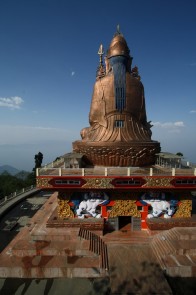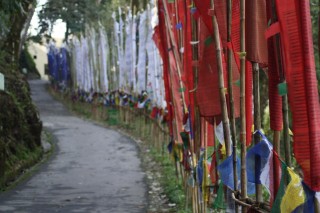 India has lots of well-known tourist highlights, such as the Red Fort in Delhi, the Taj Mahal in Aggra, the beaches in Goa or backwaters in Kerala. Fortunately we’ve seen a few of those most crowded places already. So this time we wanted to focus on lesser known places, and Sikkim is the first of them. It is the Indian state squeezed into the political danger zone between China, Nepal, Bhutan and Bangladesh. It’s the least populous state yet full of mountains, including the world’s third highest (Kanchenjunga at 8586m) and the people that are living there are seriously some of the nicest in India – less intrusive, less nosy, more polite and very helpful.
India has lots of well-known tourist highlights, such as the Red Fort in Delhi, the Taj Mahal in Aggra, the beaches in Goa or backwaters in Kerala. Fortunately we’ve seen a few of those most crowded places already. So this time we wanted to focus on lesser known places, and Sikkim is the first of them. It is the Indian state squeezed into the political danger zone between China, Nepal, Bhutan and Bangladesh. It’s the least populous state yet full of mountains, including the world’s third highest (Kanchenjunga at 8586m) and the people that are living there are seriously some of the nicest in India – less intrusive, less nosy, more polite and very helpful.
To visit Sikkim as a foreigner you need a permit, so we did all the ridiculous bureaucracy and left Darjeeling towards Sikkim. Pretty much all public transport in Sikkim (and in fact most of the Northeastern states) consists of shared jeeps. With ten people fitting into one jeep, they just leave whenever they are full and are the only vehicles that can sensibly drive on the bumpy and extremely windy and steep roads. So Sikkim has jeep stations instead of bus stations and though you’re seriously squeezed in, it is quite a fun way to travel.
Our first destination was Namchi, the capital of South Sikkim. It’s a really cute little town, almost as clean as a German town, centered around a nicely decorated pedestrian zone that features a little outdoor aquarium with goldfish, catfish and even piranhas. It lies in a saddle that is overlooked by two giant statues that occupy the hilltops on both sides – a Buddhist one in Samdruptse and a Hindu one in Solophok. Both are stunning places with amazing mountain views. There was no other foreigner in town and maybe that’s why the people were so nice to us, the food was so cheap and the cab drivers friendly instead of greedy. Unspoilt territory so to speak – we love such places.
The roads continuing from Namchi are so bad that we had to go back the way we came and up the next valley to get to West Sikkim. After a long day in several jeeps we reached sleepy Yuksom, more a village than a town, where the road really does end. It is the historic capital of the state, the place of the coronation of Sikkim’s first king in the 17th century, but since then it has not kept up with the development in other parts of the country. It is a village with flashingly green meadows, golden gompas (Tibetan monasteries) and generally a more Nepalese feel to it – no wonder as lots of ethnic Nepalis are living here. We deliberately missed the 7am jeep, the only regular transport option leaving the area. Around noon a delivery truck thundered down the only road, continously blowing his horn. After unloading all the rice, wheat and dal the truck driver turned around to go back to Pelling and agreed to take us. Probably the most touristic place in the area, Pelling has unrivalled views of Kanchenjunga. Even with the thin mist that blocked our views from Darjeeling, the mountain is so close here, you can still see it. It took us some 7 hours with loads of different vehicles to get back to Darjeeling the next day, but our little tour through this remote Indian state with the friendly people and lots of dead ends was totally worth it.








